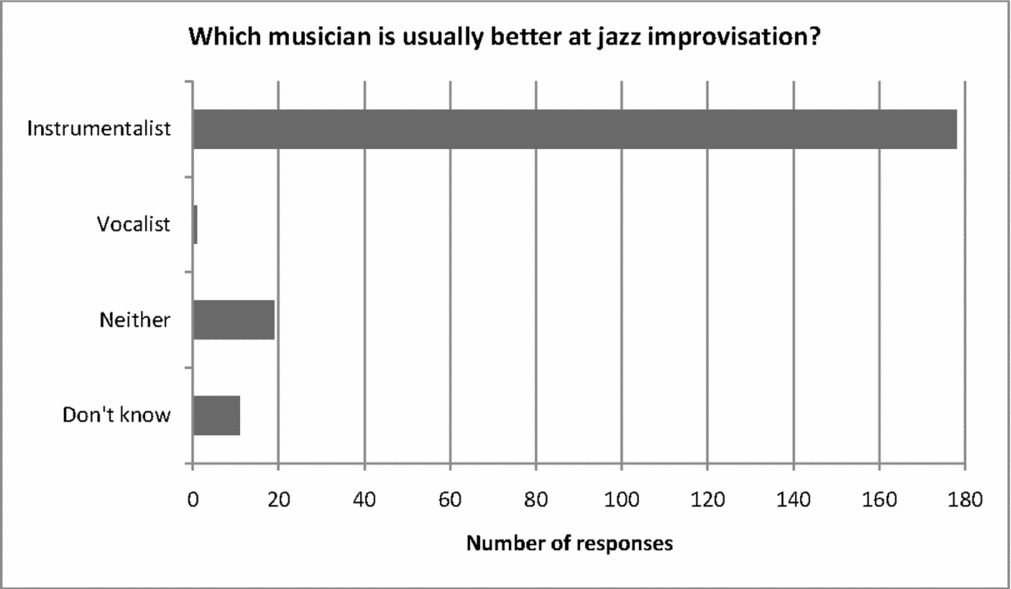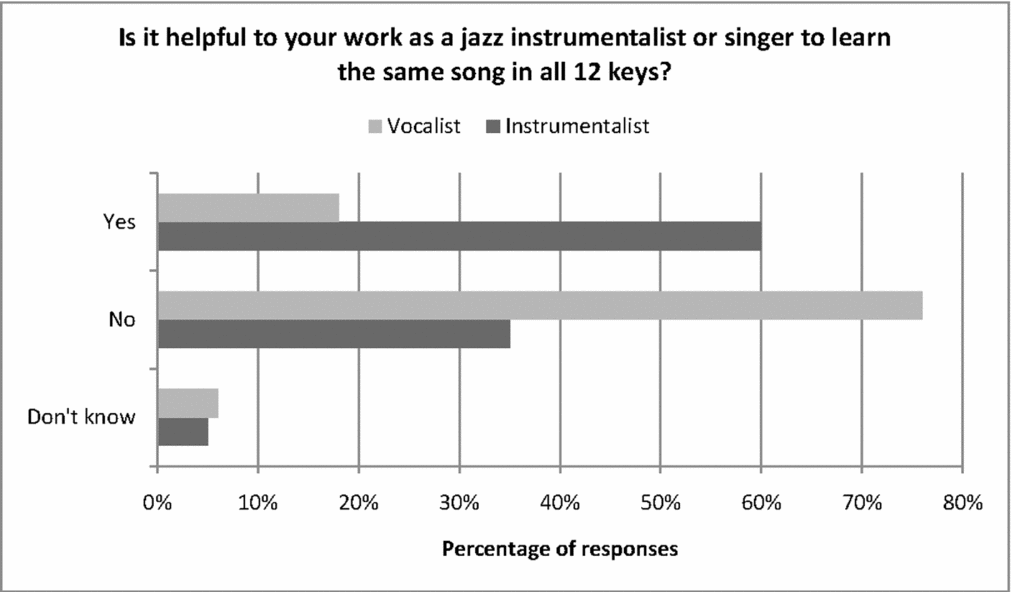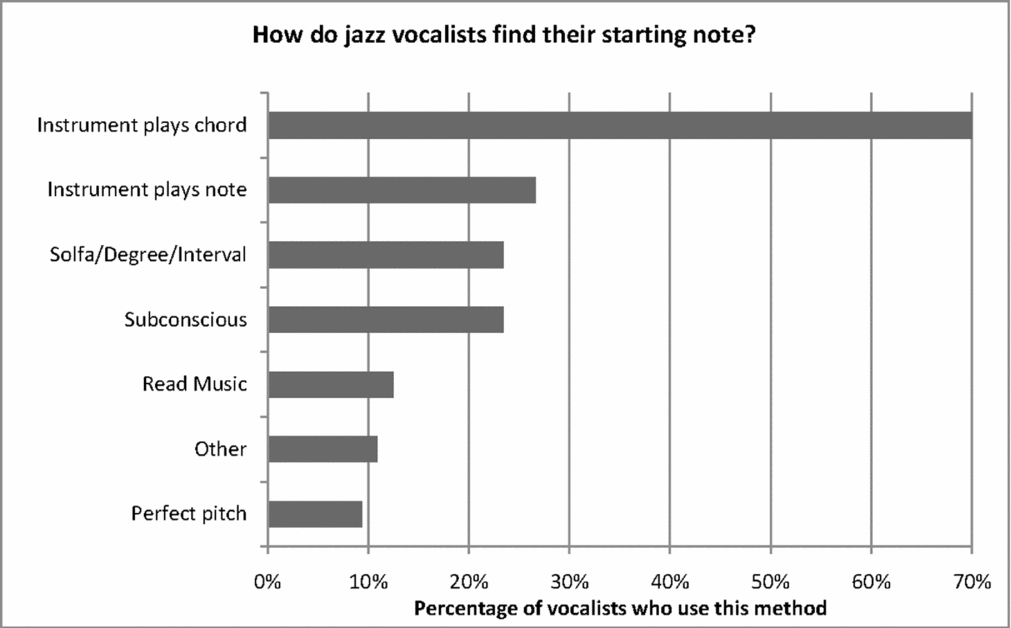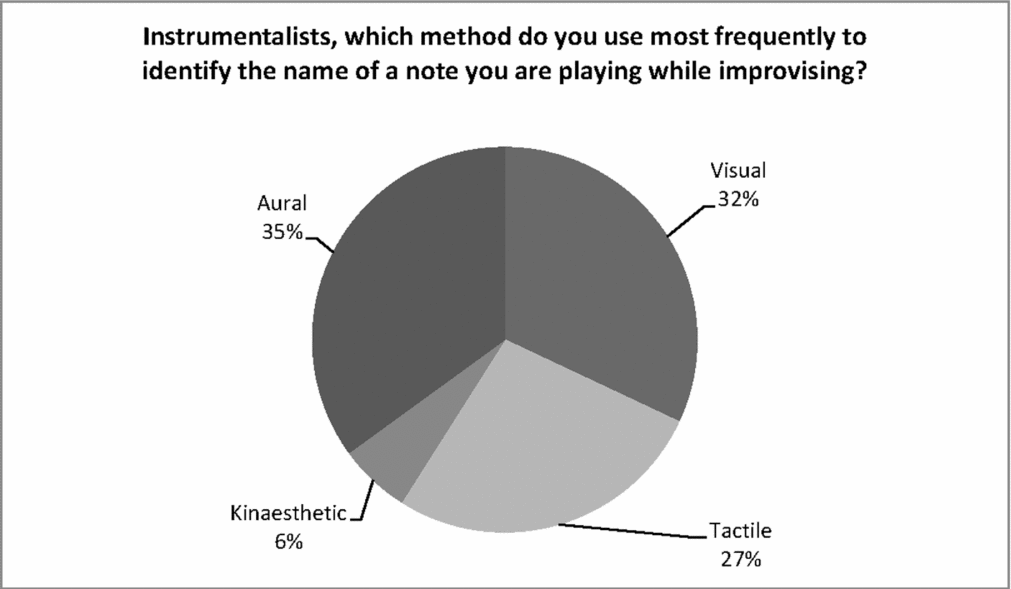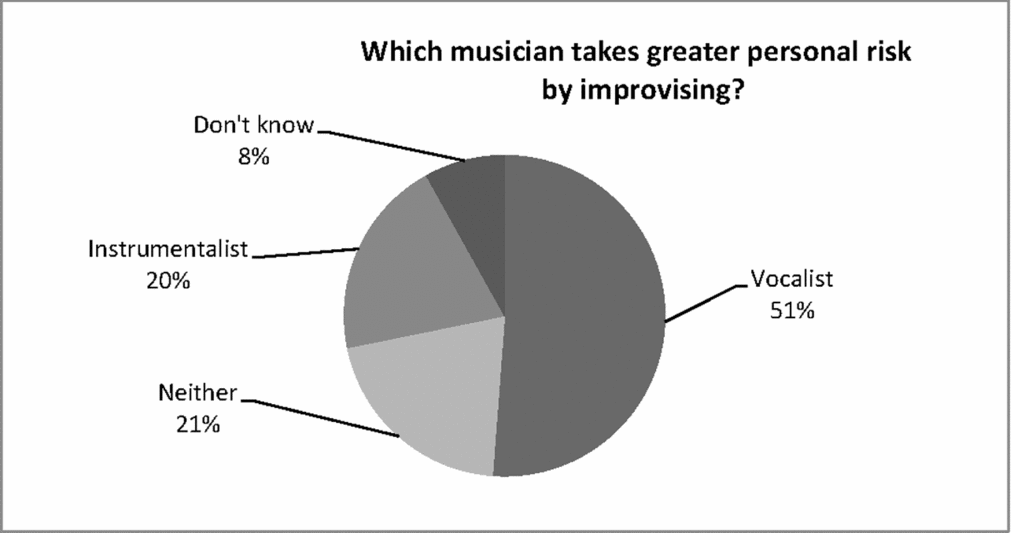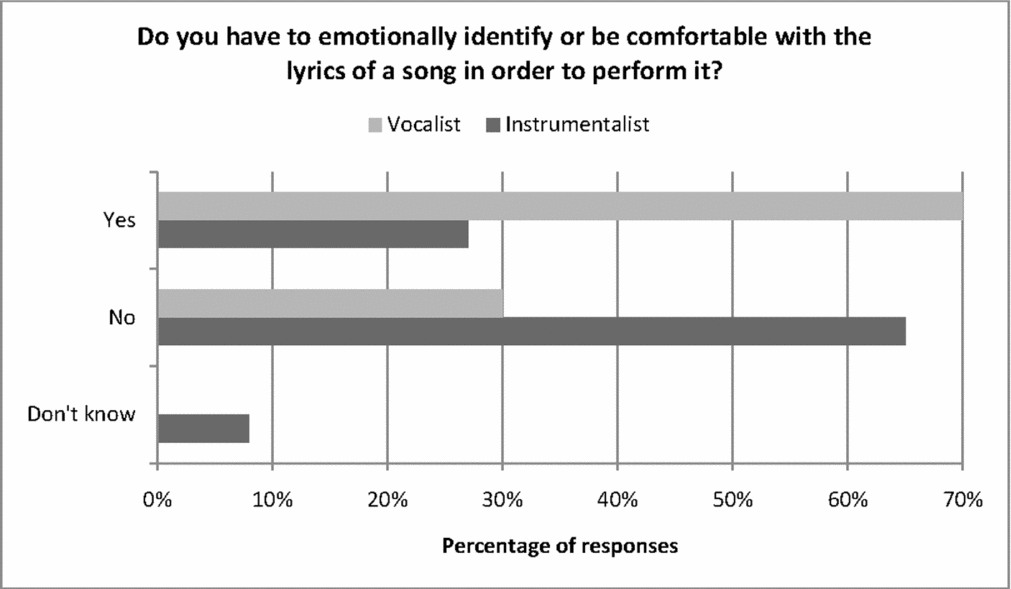Casual observers of television crime shows are probably familiar with the occupation of a profiler. A profiler pinpoints specific characteristics of a perpetrator in a criminal investigation. A list of identifying features is then issued by the police in the form of a BOLO (‘Be On the Look Out for’) that will, they hope, lead to an arrest. Profiling is also a compatible framework for alerting music teachers to the unique educational needs of jazz vocalists.
This researcher's interest in identifying the singer's distinct qualities grew from observing the musician's common opinion that jazz vocalists do not achieve as well in improvisation as instrumentalists (e.g. Coker & Baker, Reference COKER and BAKER1981, p. 4; Grime, Reference GRIME1983, p. 112; Pressing, Reference PRESSING and Sloboda1988, p. 135; Weir, Reference WEIR2001, p. 12). While some outstanding exceptions are evident, such as Ella Fitzgerald, Mark Murphy and Betty Carter, there remains a general perception that, as Greennagel (Reference GREENNAGEL1994, p. 5) writes, jazz singers ‘suffer from a reputation as being exceptionally inadequate improvisers’. The vocalists’ perceived lag in achievement becomes particularly apparent in the improvisation classroom. Amongst the myriad of different instruments, singers are distinguishable as a misfit. Craig Scott (personal communication, November 18, 2010), Chair of Jazz Studies at the Sydney Conservatorium of Music, recalled how vocalists were initially included in improvisation classes yet later removed because it ‘just simply didn't work’. The words ‘just didn't work’ were echoed across the Pacific by jazz educator Larry Lapin when describing the integrated improvisation classes at the University of Miami (Greennagel, Reference GREENNAGEL1997, p. 40). What becomes apparent in these cases is that singers are differentiated from other jazz musicians, usually in less favourable terms.
For educators, identifying differences in a body of students can be a valuable exercise as it brings into focus the difference between the legal meaning of the words equal and equitable. Equal treatment of two parties will not necessarily result in equal outcomes if the parties begin on different footings. Equity in education acknowledges that, for comparable results to be achieved, unique needs, advantages and disadvantages must be recognised. Likewise, jazz vocalists may require equitable teaching strategies to address their characteristics if they are expected to perform equally to instrumentalists. This paper therefore will respond to the need to distinguish vocalists by creating a profile of some of their features. The statistics used to construct the profile are drawn from a larger study which utilises a questionnaire and interviews with professional jazz musicians to explore differentiations between improvising vocalists and instrumentalists. For this paper, five significant characteristics of the jazz vocalist are highlighted for exploration. The features are incorporated into the general discussion alongside references in jazz literature and suggestions for how teachers in adult jazz education can address the differences.
Methodology
Data for this paper were extracted from The National Survey of Jazz Instrumentalists and Vocalists (Hargreaves, Reference HARGREAVES2010), conducted in Australia and instigated as one portion of a larger project. The survey was self-administered online and by post over a period of 6 months, concluding in early 2010. Following ethical approval, participants were recruited via an open invitation extended to professional jazz musicians circulated by mail, email, websites, flyers, newsletters, telephone and radio across Australia to jazz clubs, tertiary institutions and jazz musicians’ organisations. The qualifying criteria for participation required respondents to be 18 years or older and currently residing and performing as a professional jazz musician in Australia. The survey was anonymous and utilised predominantly multiple choice questions, and one open-ended question. A total of 209 jazz musicians participated (female, n = 60; male, n = 149), including 64 vocalists and 145 instrumentalists. The results were analysed with the statistics software PASW Statistics, utilising chi square analysis.
An initial question in the survey tested the underlying premise that there is a perception that vocalists are poorer improvisers than instrumentalists. As can be seen in Figure 1, a clear majority of 85.2% (n = 178) indicated that, from their experience, the instrumentalist is a better improviser. The result is in stark contrast to the mere 0.5% (n = 1) who elected vocalists. From this foundation, five statistically significant characteristics in the jazz singer's profile arose.

Fig. 1 Responses to a question testing the perception of improvisation achievement taken from the National Survey of Jazz Instrumentalists and Vocalists (Hargreaves, Reference HARGREAVES2010).
Characteristic 1: The jazz singer uses imitation more frequently when learning music
The learning of repertoire is an important process in the development of a jazz musician (Berliner, Reference BERLINER1994, pp. 64–65). The survey shows that there is a different emphasis between vocalists and instrumentalists when approaching the task. Forty-two per cent of respondents found that, in their experience, singers use imitation more frequently than instrumentalists when learning music whilst only 13% of respondents reported that instrumentalists do so. A further 30% selected ‘neither’ and 15% selected ‘don't know’. The perception that imitation is favoured by vocalists above other musicians is understandable given it is the primary method humans use for learning another vocal act: speaking. What may be of interest to the voice teacher, however, are the negative consequences when imitation is relied upon as the only option for learning music.
One consequence, as shown in literature, is the link between learning music by imitation and experiencing speed. For example, noted jazz vocal pedagogue Bob Stoloff remarks, ‘Singers have great ears: they can learn fast and they can imitate fast’ (Wadsworth, Reference WADSWORTH2005, p. 188). Jazz educator DiBlasio (Reference DIBLASIO1996, p. 35) implores musicians to engage in scatting because ‘It's the quickest way to hear something before dealing with an instrument’. Jazz singer Sheila Jordan explains that she struggles with reading music because, ‘I can hear it quicker than I can read it’ (Enstice & Stockhouse, Reference ENSTICE and STOCKHOUSE2004, p. 167).
To test how familiar vocalists are with an experience of learning songs quickly through imitating, the survey asked, ‘Do you usually find it quicker to learn a new song by listening and imitating rather than reading music?’ Fifty-nine per cent of vocalists indicated ‘yes’ compared with only half that number who indicated ‘no’ (30%). The remaining 11% indicated that they never learn songs by reading music. If those who indicated ‘yes’ are combined with those who indicated that they never learn by reading, there is a potential 70% of vocalists who may be experiencing a sense of speed when learning music by imitation.
For jazz instrumentalists, although learning by ear may also be a fast alternative for skilled players, the necessity to translate the sounds into absolute pitches with specific fingering on an instrument can elongate the time spent rehearsing a song. To reiterate DiBlasio's comment above, after hearing something, players then have to ‘deal with an instrument’ to recreate the tune. Instrumentalists are also faced with the time-consuming demand of reproducing the tune in multiple key signatures. This practice appears to be a hallmark of committed jazz instrumentalists. Berliner (Reference BERLINER1994, p. 82) observes that young instrumentalists ‘embark on the correspondingly arduous course of learning to reproduce the relative movements of a composition's progression in every key’. Saxophonist Michael Cogswell recounted how his teacher instructed him to practice his tunes ‘slow, medium and fast in all twelve keys . . . That's the way Bird [Charlie Parker] did and I did it and if you want to do it that's the way you got to do it too’ (Pellegrinelli, Reference PELLEGRINELLI2005, p. 215).
The survey showed instrumentalists find the learning of repertoire in multiple keys to be a beneficial practice (see Figure 2). When asked if it is ‘helpful to your work as a jazz instrumentalist/singer to learn the same song in all 12 keys’, a very highly significant relationship was observed between whether participants were instrumentalists or vocalists, and their response (χ2 (2) = 35.111, p < 0.000). Sixty per cent of instrumentalists indicated that it is a helpful practice compared with only 18% of vocalists. Seventy-six per cent of vocalists indicated that it is not helpful. These data support the likelihood that instrumentalists spend a comparatively longer time practising a song due to mastering it in multiple keys. Singers, in contrast, have less to gain from the process and are more likely to move on.

Fig. 2 Responses to a question ascertaining the perceived usefulness of learning songs in 12 keys, taken from the National Survey of Jazz Instrumentalists and Vocalists (Hargreaves, Reference HARGREAVES2010).
The overall problem with vocalists learning songs quickly by ear is that it may encourage them to place less value on reading music. Reading music is a time-consuming skill to develop and creates new difficulties in forcing vocalists to think in the world of absolute pitch. Music literacy may appear unnecessary when imitation already fulfils the need adequately for learning repertoire. Singer Marilyn Moore aptly sums up the consequence of learning by imitation: ‘It's so hard to back up and go back to kindergarten and learn all these things when you really want to sing. You're so damn spoiled. You're so used to that immediacy – immediate gratification’ (Grime, Reference GRIME1983, p. 81).
Poor music reading skills have been observed in vocalists in jazz research. Wadsworth's (Reference WADSWORTH2005) study found that several master-pedagogues of jazz vocal improvisation acknowledge that many singers have not developed ‘music reading, to the same extent as instrumentalists’ (p. 180). In particular, pedagogue Phil Mattson observes, ‘You can't play in a 4th grade band without learning how to read, but you can sing in a very fine high school choir without knowing anything other than the notes are going up or down’ (Wadsworth, Reference WADSWORTH2005, p. 181).
A further consequence of the singers’ poor music literacy is that it may inadvertently discourage them from becoming independent musicians. For example, Alt (Reference ALT2004, pp. 389–393) points out that if singers are only trained by listening repetitively, they will always be reliant on others to read. He notes that, in the professional setting, there is often little time for that kind of attention. Likewise, Wadsworth (Reference WADSWORTH2005, p. 261) connects the vocalists’ failure to act assertively when requesting keys and tempos with this lack of understanding.
Acknowledging the jazz vocalist's natural preference for learning songs by imitation brings to the foreground the opportunity to adjust the emphases in music education to address singers’ specific needs. Teachers can better appreciate how the reticence of singers to learn music reading inadvertently undermines their musical development. A healthy regard for music literacy can be proactively fostered in singers to counterbalance their tendency to rely on imitation, and thus develop them as independent, skilful musicians.
Characteristic 2: The jazz singer finds the starting note from a chord an instrument plays
The method by which singers find their starting note is of particular relevance to jazz students. While classical singers typically benefit from the predictability of a prescribed introduction, jazz singers may not have the same degree of certainty. Accompaniment can range from big band arrangements to live jazz trios whose repertoire of standards is entirely in the instrumentalists’ heads. For the latter, introductions are as spontaneous as the rest of the performance. Even when a jazz combo uses a lead sheet notating the harmonic progression of an introduction, the instrumentalist's variation in chord voicing may greatly challenge a singer. Guitarist Paul Bollenback (McNulty, Reference MCNULTY2007, p. 18) provides an illustration of the difficulty: ‘In bar five of “I Should Care”, the chord is a Bmin7b5, with F natural as the melody. Even though it might seem hip to play a Bm11 voicing with the E on top, that E will not support the F that is the sung melody note, and can easily cause even the best singer to go flat.’ Should this very scenario occur as the final chord of an introduction before the vocal entry, vocalists are likely to be severely challenged to accurately pitch their starting note. With this in mind, it would be helpful to know how singers find their note so educators can best enable the process.
In the survey, vocalists were asked to indicate all the methods they use to find their starting note when singing a familiar jazz song with accompaniment. As shown in Figure 3, the most frequently selected answer was ‘an instrument plays a chord and I pick the note from the chord’ (70%). The remaining options were selected far less frequently. They included ‘an instrument plays the starting note for me’ (27%); ‘having heard the opening note or chord, I use solfa, scale degrees or intervals to calculate where to start’ (23%); ‘I read the music and calculate the distance from a known pitch an instrument plays’ (13%); and ‘I use perfect pitch’ (9%).

Fig. 3 Responses to a question ascertaining the methods vocalists utilise to find their starting note, taken from the National Survey of Jazz Instrumentalists and Vocalists (Hargreaves, Reference HARGREAVES2010).
Another option that was selected was ‘I'm not sure how I find the starting note. It's subconscious’ (23%). The results cannot show if the process remains unknown to these respondents by choice or because of their inability to access subconscious thought. However, regardless of the reason, it reveals that nearly one quarter of vocalists rely on the inexplicable to pluck their note from the air. It may be a successful approach given its relative popularity but it has a vulnerability. Should the method ever fail (i.e. the subconscious does not deliver the correct starting pitch), performers may have difficulty rectifying the problem because they have no knowledge of what went wrong.
The identification of how jazz vocalists find their starting pitch has implications for jazz teachers. If selecting a note from a chord is the most common method, then it seems appropriate to ensure vocal students are equipped for the task. A combination of ear training and music theory with an emphasis on chords is likely to be helpful. Students may be taught to recognise and perform triads and 7th note chords, distinguish major, minor, diminished and augmented chords, manoeuvre up and down the arpeggios and rest on prescribed tones at will. Understanding in theory and in practice the upper extensions of chords can connect knowledge with sound in a way to serve the jazz vocalist's needs. Beyond familiarity with chords, it is in the singer's interest to explore additional back-up methods for locating a starting pitch. Other strategies singers in the survey indicated they use to calculate the pitch are solfa, scale degrees and intervals, reading music, utilising perfect pitch, and asking an instrumentalist to play the starting note. Overall, the more methods at the disposal of students, the greater their options for meeting this unique challenge.
Characteristic 3: The jazz singer uses aural feedback as the dominant source for pitch placement when improvising
Singing, like other physical tasks, utilises the information of sensory feedback to monitor the performance of a skill (Nisbet, Reference NISBET and Harrison2010). The preference of vocalists to rely on aural feedback for pitch placement seems self evident. There is no direct, natural access to visual or tactile feedback from their instrument (Pressing, Reference PRESSING and Sloboda1988, p. 135) and the kinaesthetic information which the body supplies is not precise enough to be linked to specific frequencies. Vocalists were asked in the survey, ‘Which method do you use most to help pitch notes when you are improvising?’ The vast majority (94%) indicated a preference for using aural feedback over kinaesthetic feedback (6%) to pitch notes when improvising. Here a distinctive difference is visible when contrasted with instrumentalists.
In the survey, instrumentalists were asked first if they identify the name of a note while improvising. Those who indicated they did were then asked to ‘Rank from most frequent to least frequent the method you use to identify the name of a note you are playing while improvising’. Thirty-five per cent used aural feedback most frequently, compared with 32% who used visual, 27% tactile and 7% kinaesthetic. In Figure 4, there is virtually a three-way split between the preferred methods of visual, aural and tactile feedback, with only a small portion selecting kinaesthetic.

Fig. 4 Responses to a question ascertaining which methods instrumentalists use most frequently to identify the name of a note, taken from the National Survey of Jazz Instrumentalists and Vocalists (Hargreaves, Reference HARGREAVES2010).
The implications of this division are two-fold. First, it shows that while aural feedback is a popular preference, instrumentalists are almost as likely to favour visual or tactile information. In other words, the three sources appear equally informative and utilised, whereas vocalists are restricted to aural feedback as their only viable option. Pressing (Reference PRESSING and Sloboda1988, p. 135) identifies this as the likely cause of the vocalists’ difficulty with achievement in improvisation. The second implication is there is potential for the three major sources of motor feedback to be simultaneously combined to supply reinforced information for instrumentalists, over and above that available to vocalists from their singular source. These differences in quantity (three sources) and quality (triangulation) of feedback together create an inequitable starting position for vocalists when compared with other musicians.
Recommendations are difficult to suggest for jazz voice teachers regarding the singer's use of motor feedback in pitch placement and identification. One cannot permanently manufacture the missing sources of visual and tactile feedback from which instrumentalists benefit. Perhaps the only recourse is to aim to develop exquisite aural skills in student vocalists in order to extract the very most they can from this source of information. Teachers can actively foster methods to help vocalists manoeuvre between the ethereal dimension of relative pitch where singers frequently reside, and the concrete world of absolute pitch in which instrumentalists operate. Teaching vocal students to read music, master solfa, negotiate through scale degrees and intervals all provide cognitive clues to the identification of absolute pitch once a point of reference is given. These tools may potentially empower vocalists in a field where they are deficient by nature.
Characteristic 4: The jazz singer takes a greater personal risk than an instrumentalist by improvising
Improvising is a daunting act on many levels. Aside from being one of the most complex cognitive tasks a musician can perform (Campbell, Reference CAMPBELL1991, p. 23), the absence of the safety net of a predetermined melody and rhythm positions the performer constantly on the threshold of success or failure. How to deal with fear is a common enquiry from teachers at workshops (e.g. Garcia, Reference GARCIA1996, p. 57).
While risk is relevant to all musicians, literature suggests that vocalists are already in a position of greater vulnerability before improvising. The singer's ‘instrument’ is the only musical instrument that resides completely within the human body. There are two specific consequences of this with potential to affect the performer's confidence. First, the vocal instrument is highly sensitive to the status of the body, resulting in an instrument with a large degree of variability. Jazz singer Mel Torme provides an example: ‘I have to tell you that as a human mechanism and not a machine, my singing is affected considerably by say my domestic life or whatever affects me personally’ (Roland, Reference ROLAND1999, p. 125). Author of The Mastery of Music, Barry Green, summarises the overall vulnerability of the vocal apparatus by describing it as a ‘peculiarly troublesome instrument’ (Reference GREEN2003, p. 220).
One particular vulnerability for singers comes from the physiological consequences produced by fear. For musicians, fear often manifests as performance anxiety. The frequent references to it in vocal texts demonstrate that it is a common problem for singers (e.g. Doscher, Reference DOSCHER1994; Bunch, Reference BUNCH1997; Peckham, Reference PECKHAM2000; Thurman & Welch, Reference THURMAN and WELCH2000). The effect it exerts on the functioning of the vocal apparatus may result in destabilisation of the instrument itself (McKinney, Reference MCKINNEY1994). It contributes to ‘a whole world of vulnerability that pianists, percussionists and other instrumentalists simply never have to face’ (Green, Reference GREEN2003, p. 220) (emphasis in the original).
The second consequence of the vocal apparatus being housed within the body is the perception that the human voice is the outward expression of the inner soul. Green (Reference GREEN2003, p. 221) encapsulates the sentiments of singer Frederica von Stade when he paraphrases her thus: ‘you cannot separate your voice from your body or soul, because it is directly subject to everything you are thinking and feeling.’ Welch (Reference WELCH, Miell, MacDonald and Hargreaves2005, p. 245) expresses a similar perspective when describing the voice as ‘an essential aspect of our human identity: of who we are, how we feel, how we communicate, and how other people experience us.’ Doscher (Reference DOSCHER1994, p. 256) expresses her belief simply: ‘. . . a singer's concept of self cannot be separated from his/her instrument’.
The concern with perceiving the voice as a window to the soul is the frequency with which flaws naturally occur in jazz improvisation. Improvisation is regarded as a form of linear composition where ideas are conceived then performed without the opportunity to rework or replace them (Johnson-Laird, Reference JOHNSON-LAIRD1987, p. 77). As a result, the presence of imperfections is a characteristic of the genre. Berliner (Reference BERLINER1994, pp. 379–383) provides many examples demonstrating mistakes are integral to the art form. Unfortunately, if the voice represents a person, the vocalist may be seen as deeply flawed and as unattractive as the unresolved dissonance coming out of the mouth. The strong association between voice and personal representation creates the potential to perceive imperfections sung while improvising as symptoms of imperfections in character.
In light of the vulnerabilities which pre-exist in the vocalist, it is worth considering whether singers are perceived to risk more than instrumentalists when improvising. The survey asked participants to indicate from their experience, ‘which musician takes greater personal risk by improvising’. Slightly more than half of the respondents selected ‘vocalists’, while only 20% selected ‘instrumentalists’ (see Figure 5).
Despite support for the conjecture, the results do not reveal why vocalists are more frequently perceived as taking greater risk. Future research is required to verify any hypothesis. However, regardless of the reason, the data suggest that it would be beneficial for voice students to be taught methods for self-assurance to compensate for the perceived increased vulnerability. Teachers can address this need by accessing some helpful books which discuss fear, performance anxiety and protecting self-esteem. In particular, the works of Werner (Reference WERNER1996), Bonetti (Reference BONETTI1997), Emmons and Thomas (Reference EMMONS and THOMAS1998), Rigby (Reference RIGBY2001) and Evans (Reference EVANS2003) provide practical suggestions which can be incorporated into voice lessons.

Fig. 5 Responses to a question testing the perception of which musician takes greater personal risk by improvising, taken from the National Survey of Jazz Instrumentalists and Vocalists (Hargreaves, Reference HARGREAVES2010).
Characteristic 5: The jazz singer must emotionally identify or be comfortable with the lyrics of a song in order to perform it
The final BOLO characteristic this paper identifies is concerned with the unique role vocalists have of delivering lyrics. While instrumentalists may express meaning and interpretation through musical performance, the direct conveying of words is the province of singers. The literature is brimming with references to the need for singers to emotionally connect with the lyrics. Cooper (Reference COOPER2003, p. 156), in her article ‘Once more with feeling’, directs vocalists to ‘find personal meaning’. Singer Betty Carter declares, ‘If you've got any feeling at all, there's NO WAY you can get up and sing those lyrics if you don't feel them, believe in them’ (Gourse, Reference GOURSE2001, p. 336) (emphasis in the original). Likewise, performer Cassandra Wilson says, ‘In order to get across to people the emotion of the song, it's very important to identify with it’ (Enstice & Stockhouse, Reference ENSTICE and STOCKHOUSE2004, p. 340). Even the legendary Billie Holiday revealed in her autobiography, ‘The whole basis of my singing is feeling. Unless I feel something, I can't sing’ (Holiday & Dufty, Reference HOLIDAY and DUFTY1956, p. 165).
The literature suggests that the vocalist's responsibility for verbal communication carries with it a charge of integrity in expression which influences song selection. Singer Tony Bennett implores: ‘Don't ever sing anything that you don't feel’ (Gourse, Reference GOURSE2001, p. 296) while Sylvia Syms gives a more specific example: ‘I couldn't sing “The Boy Next Door”, because the boy next door is a grandfather’ (Gourse, Reference GOURSE2001, p. 308).
The perception that integrity is essential to a vocalist's performance of lyrics is refuted by some. Researcher Pellegrinelli (Reference PELLEGRINELLI2005, p. 269) presents a counterargument, deeming it an unfortunate ‘romantic fallacy’ that vocalists sing what they feel or select only those songs they have lived. Jazz musician Dave Frishberg shares the perspective: ‘You're going to sing “Misty” like it meant something? Nobody but an idiot is going to believe those lyrics and try to sing them as if they meant something. It's a mood: you can't get meaning out of it, there's nothing there to express’ (Grime, Reference GRIME1983, p. 105) (emphasis in the original). Likewise, Bob Dorough (Grime, Reference GRIME1983, p. 318) acknowledges that although lyrics are paramount to him, Sarah Vaughan and Ella Fitzgerald ‘are always singing asinine songs, and, by using their musical voices, they can make the songs beautiful’.
Whether emotional identification is a necessity or not, the survey sought to ascertain how influential its perception is on vocalists and instrumentalists. Survey participants were asked, ‘Do you have to emotionally identify or be comfortable with the lyrics of a song in order to perform it?’ Figure 6 shows a clear difference in responses between vocalists and instrumentalists. Seventy per cent of singers selected ‘yes’ compared with 27% of instrumentalists. Instrumentalists answered ‘no’ 65% of the time. Chi square analysis revealed a very highly significant relationship between whether musicians were vocalists or instrumentalists, and whether they have to emotionally identify or be comfortable with the lyrics of a song in order to perform it (χ2 (2) = 36.625, p < 0.000).

Fig. 6 Responses to a question ascertaining the need to emotionally identify or be comfortable withlyrics in order for jazz performers to perform a song, as taken from the National Survey of Jazz Instrumentalists and Vocalists (Hargreaves, Reference HARGREAVES2010).
This statistical distinction between instrumentalists and singers shows that the priority placed on expressive integrity is another difference deserving consideration by the jazz teacher, particularly when selecting repertoire for voice students. For example, a teacher's song selection may be motivated by style and technical suitability for the student. If the student is unable to identify with the lyrics, the discomfort may manifest itself in low motivation and uncertainty or the guise of technical singing difficulties. This observation is not meant to imply that the teacher's repertoire choice must always be subject to a student's comfort test. Instead, awareness of the issue may provide opportunity to discuss its place and influence in the professional jazz world.
The classroom can provide a place for experimenting with strategies for dealing with the vocalist's conflict between comfort and lyrics. For example, students can consider how singing uncomfortable lyrics physically affects their vocal performance. They can experiment with disconnecting from meaning and concentrate on making a beautiful sound, as Bob Dorough observed Ella Fitzgerald doing. Alternatively they can try delivering an offensive line with tongue in cheek or place a different emphasis in a phrase to alter the meaning. Additional methods to consider are encouraging students to assume the role of a character to whom they can comfortably attribute the sentiment of the lyrics as opposed to viewing it as a representation of themselves. Students may also prefer to give a spoken introduction before the song to clearly attribute the words to the lyricist. Sometimes alternative versions of lyrics can be found in print or in the recordings of professional singers. Experimenting in the classroom with these approaches may assist vocalists to deal with the greater emphasis they place on expressive integrity compared with jazz instrumentalists.
Conclusion
Data gathered from the National Survey of Jazz Instrumentalists and Vocalists demonstrates that there are distinct characteristics which differentiate the singer's learning experience from the instrumentalist's. To summarise the differentiations, the jazz singer's BOLO looks like this:
Be On the Look Out for a jazz singer who:
• uses imitation to learn music
• uses a chord to find a starting note
• uses aural feedback to negotiate pitches
• takes great personal risk by improvising
• desires to be comfortable with the lyrics of a song when performing it.
Each of the five features discussed here bear consequences for the teacher of jazz singing. To ignore them and treat singers identically to instrumentalists is to ignore the principle of equity and risk ignoring these distinctive features in a vocalist's development of musicianship.
The collection of distinguishing features which has been presented in this paper provide a starting place for change. Whether these changes ultimately lead to an improvement in jazz vocal performance would require each differentiation to be isolated and individually measured in comparative studies of achievement. Regardless, this paper establishes that differences do exist and that the music educator can address their management.
This paper will conclude with the issuing of a second BOLO. The BOLO will not be for the jazz singer but instead for educators who are keen to equip appropriately singing students for the world of jazz.
Be On the Look Out for a jazz educator who:
• balances the advantages of learning by imitation with promoting music reading skills
• teaches both theoretical and aural familiarity with chords
• fosters exquisite aural skills and other tools helpful for negotiating relative and absolute pitch
• equips students with strategies for remaining self-assured while risking much
• empowers students with techniques for singing uncomfortable lyrics.
This music teacher will be charged with the crime of recognising and accommodating the idiosyncrasies of jazz singers.
Wendy Hargreaves is a contemporary voice teacher, performer, composer and researcher in Australia. Wendy taught classroom music in several Brisbane schools prior to undertaking a Master of Music, at the Queensland University of Technology. Interspersed with performing, she is currently a PhD candidate at the Queensland Conservatorium of Music, Griffith University, researching the unique educational experiences of jazz vocal improvisers.




